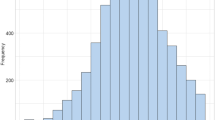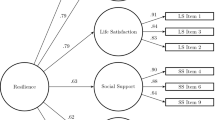Abstract
The present study was conducted in the context of current concerns about replication in psychological research. It claims that risk factors should be regarded as an integral part of the definition of individual resilience, which should be defined in terms of the balance between individual strength or protective factors, and individual vulnerability or risk factors (IND-SVR). Five independent samples, including 3457 Israeli participants, were employed to determine the effects of resilience promoting and resilience suppressing variables on the IND-SVR index of resilience, and on its two components: recovery from adversity, and distress symptoms. Five path analyses were employed for determining the role of distress symptoms as a measure of psychological resilience, as compared to other indices of this resilience. Results indicated the major role of risk factors (distress symptoms) as an integral component of resilience. This role was generally replicated in the five investigated samples. Risk factors are legitimate, valid, and useful parts of the definition of psychological resilience. Resilience research has shifted away from studying individual risk factors to investigating the process through which individuals overcome the hardships they experience. The present data seem to suggest that this shift should be reexamined.





Similar content being viewed by others
References
Antonovsky, A. (1979). Health, stress and coping. San Francisco: Jossey-Bass.
Antonovsky, A. (1993). The structure and properties of the Sense of Coherence Scale. Social Science & Medicine, 36, 725–733.
Arbuckle, J. L. (2009). AMOS 19. Crawfordville, FL: AMOS Development Corporation
Bandura, A. (1989). Regulation of cognitive processes through perceived self-efficacy. Developmental Psychology, 25, 729–735.
Besser, A., Zeigler-Hill, V., Weinberg, M., et al. (2015). Intrapersonal resilience moderates the association between exposure-severity and PTSD symptoms among civilians exposed to the 2014 Israel–Gaza conflict. Self and Identity, 14(1), 1–15.
Bonanno, G. A. (2005). Resilience in the face of potential trauma. Current Directions in Psychological Science, 14(3), 135–138..
Bonanno, G. A., & Mancini, S. D. (2012). Beyond resilience and PTSD: Mapping the heterogeneity of responses to potential trauma. Psychological Trauma: Theory, Research, Practice, and Policy, 4(1), 74–83.
Bonanno, G. A., Rennick, C., & Dekel, S. (2005). Self-enhancement among high-exposure survivors of the September 11th terrorist attack: Resilience or social maladjustment? Journal of Personality and Social Psychology, 88, 984–998.
Braun-Lewensohn, O. (2014). Coping resources and stress reactions among three cultural groups one year after a natural disaster. Clinical Social Work Journal, 42(4), 366–374.
Braun-Lewensohn, O. (2015). Coping and social support in children exposed to mass trauma. Current Psychiatry Reports, 17, 46).
Braun-Lewensohn, O., Celestin-Westreich, S., Verte, D., Celestin, L. P., & Ponjaert-Kristoffsen, I. (2009a). Coping styles as moderating the relationships between terrorist attacks and well-being outcomes. Journal of Adolescence, 32, 585–599.
Braun-Lewensohn, O., Celestin-Westreich, S., Verte, D., & Ponjaert-Kristoffsen, I. (2009b). Adolescents’ mental health outcomes according to different types of exposure to ongoing terror attacks. Journal of Youth and Adolescence, 38(6), 850–862.
Charles, S. T. (2010). Strength and vulnerability integration: A model of emotional well-being across adulthood. Psychological Bulletin, 136(6), 1068–1091.
Connor, K. M., & Davidson, J. R. T. (2003). Development of a new resilience scale: The Connor-Davidson resilience scale (CD-RISC). Depression and Anxiety, 18, 76–82.
Derogatis, L. R., & Savitz, K. L. (2000). The SCL-90-R and brief symptom inventory (BSI) in primary care. In M. E. Maruish (Ed.), Handbook of psychological assessment in primary care settings (pp. 297–334). Mahwah, NJ: Lawrence Erlbaum Associates.
Diener, E., Emmons, R. A., Larsen, R. J., & Griffin, S. (1985). The satisfaction with life scale. Journal of Personality Assessment, 49, 71–75.
Dyregrov, A., Gjestad, R., & Raundalen, M. (2002). Children exposed to warfare: A longitudinal study. Journal of Traumatic Stress, 15, 59–68.
Egeland, B. R., Carlson, E., & Sroufe, L. A. (1993). Resilience as process. Development and Psychopathology, 5(4), 517–528.
Eshel, Y. (2016). Post-fire recovery to distress symptoms ratio as a measure of resilience of adolescents exposed to fire hazards. Journal of Community Psychology, 44(3), 327–333.
Eshel, Y., & Kimhi, S. (2015a). Post-war recovery to stress symptoms ratio as a measure of resilience, individual characteristics, sense of danger and age. Journal of Loss & Trauma, 21(2), 160–177.
Eshel, Y., & Kimhi, S. (2015b). Community resilience of civilians at war, a new perspective. Community Mental Health Journal, 52(1), 109–117.
Eshel, Y., & Kimhi, S. (2016). Determinants of individual resilience under missile attacks: A different perspective. Personality & Individual Differences, 95, 190–195.
Eshel, Y., Kimhi, S., & Goroshit, M. (2016). Posttraumatic recovery to distress symptoms ratio mediates relations of resilience fostering resources and their predictors. Stress and Health, 32(3), 216–223..
Eshel, Y., Kimhi, S., Lahad, M., & Leykin, D. (2016). Individual, community, and national resiliencies and age: Are older people less resilient than younger individuals? American Journal of Geriatric Psychiatry, 24, 644–647.
Eshel, Y., Majdoob, H., & Goroshit, M. (2014). Posttraumatic recovery to distress symptoms ratio: A mediator of the links between gender, exposure to fire, economic condition, and three indices of resilience to fire disaster. Community Mental Health Journal, 50(8), 997–1003.
Garmezy, N. (1991). Resilience in children’s adaptation to negative life events and stressed environments. Pediatric Annals, 20, 459–466.
Gosling, S. D., Vazire, S., Srivastava, S., et al. (2004). Should we trust web-based studies? A comparative analysis of six preconceptions about internet questionnaires. American Psychologist, 59(2), 93–104.
Hadi, F., Llabre, M. M., & Spitzer, S. (2006). Gulf War-related trauma and psychological distress of Kuwaiti children and their mothers. Journal of Traumatic Stress, 19, 653–662.
Hobfoll, S. E., & Lilly, R. S. (1993). Resource conservation as a strategy for community psychology. Journal of Community Psychology, 21, 128–148.
Hudson, S. A., & O’Regan, J. (1994). Stress and the graduate psychology student. Journal of Clinical Psychology, 50, 973–977.
Kimhi, S., & Eshel, Y. (2009). Individual and public resilience and coping with long-term outcomes of war. Journal of Applied Biobehavioral Research, 14, 70–89.
Kimhi, S., & Eshel, Y. (2015). The missing link in resilience research: Commentary on the Bonanno, Romero and Klein’s paper “Temporal elements of psychological resilience”. Psychological Inquiry, 26(2), 181–186.
Kimhi, S., Eshel, Y., Leykin, D., & Lahad, M. (2017). Individual, community and national resilience in peace-time and in the face of terror: A longitudinal study. Journal of Loss & Trauma, 22(8), 698–713.
Kimhi, S., Eshel, Y., Zysberg, L., & Hantman, S. (2010). Sense of danger and family support as mediating adolescents’ distress and recovery in the aftermath of war. Journal of Loss and Trauma, 15, 351–369.
Kimhi, S., Hantman, S., Goroshit, M., Eshel, Y., & Zysberg, L. (2012). Elderly people coping with the aftermath of war: Resilience vs. vulnerability. American Journal of Geriatric Psychiatry, 20, 391–401.
Kimhi, S., & Shamai, M. (2004). Community resilience and the impact of stress: Adult response to Israel’s withdrawal from Lebanon. Journal of Community Psychology, 32, 439–451.
Lazarus, R. S., & Folkman, S. (1984). Stress, appraisal, and coping. New York: Springer.
Luthar, S. S. (1991). Vulnerability and resilience: A study of high–risk adolescents. Child Development, 62, 600–616.
Luthar, S. S., Cicchetti, D., & Becker, B. (2000). The construct of resilience: A critical evaluation and guidelines for future work. Child Development, 71, 543–562.
Masten, A. S. (2011). Resilience in children threatened by extreme adversity: Frameworks for research, practice, and translational synergy. Development and Psychopathology, 23, 493–506.
Masten, A. S. (2015). Pathways to integrated resilience science. Psychological Inquiry: An International Journal for the Advancement of Psychological Theory, 26(2), 187–196.
Nilsson, K. W., Leppert, J., Simonsson, B., et al. (2010). Sense of coherence and psychological well-being: Improvement with age. Journal of Epidemiology and Community Health, 64, 347–352.
Richardson, G. E. (2002). The metatheory of resilience and resiliency. Journal of Clinical Psychology, 58, 307–321.
Schwarzer, R., & Jerusalem, M. (1995). Generalized self-efficacy scale. In J. Weinman, S. Wright & M. Johnston (Eds.), Measures in health psychology: A user’s portfolio. Causal and control beliefs (pp. 35–37). Windsor: NFER-NELSON.
Scott, S. B., Poulin, M. J., & Cohen Silver, R. (2012). A lifespan perspective on terrorism: Age differences in trajectories of response to 9/11. Developmental Psychology, 49(5), 986–998.
Shamai, M., & Kimhi, S. (2007). Teenagers’ response to threat of war and terror: The impact of gender and social systems. Community Mental Health Journal, 43, 359–374.
Solomon, Z., & Lavi, T. (2005). Israeli youth in the second Intifada: PTSD and future orientation. Journal of the American Academy of Child and Adolescent Psychiatry, 44(11), 1167–1175.
Solomon, Z., Mikulincer, M., & Benbenishty, R. (1989). Locus of control and combat related post-traumatic stress disorder: The intervening role of battle intensity, threat appraisal and coping. British Journal of Clinical Psychology, 28, 131–144.
Solomon, Z., & Prager, E. (1992). Elderly Israeli holocaust survivors during the Persian Gulf War: A study of psychological distress. The American Journal of Psychiatry, 149, 1707–1710.
Southwick, S. M., Bonanno, G. A., Masten, A. S., Panter-Brick, C., & Yehuda, R. (2014). Resilience definitions, theory, and challenges: Interdisciplinary perspectives. European Journal of Psychotramatology. https://doi.org/10.3402/ejpt.v5.25338.
Stroebe, W., & Stroebe M. S. (1987). Bereavement and health. New York, NY: Cambridge University Press.
Thoits, P. A. (1995). Stress, coping, and social support processes: Where are we? What next? Journal of Health and Social Behavior, 31, 53–79.
Ungar, M. (2011). The social ecology of resilience: Addressing contextual and cultural ambiguity of a nascent construct. American Journal of Orthopsychiatry, 81(1), 1–17.
Yasien-Esmael, H., Eshel, Y., & Rubin, S. S. (2018). Resilience and adjustment to widowhood in the Israeli Arab Muslim society: A new perspective. Journal of Community Psychology, 46(2), 158–170.
Zimmet, G. D., Dahlin, N. W., Zimmet, S. G., & Farley, K. G. (1988). The multidimensional scale of perceived social support. Journal of Personality Assessment, 52, 30–41.
Author information
Authors and Affiliations
Corresponding author
Ethics declarations
Conflict of interest
The authors declare that they have no competing interests.
Research Involving Human and Animal Participants
This article does not contain any studies with human or animal subjects performed by any of the authors.
Rights and permissions
About this article
Cite this article
Eshel, Y., Kimhi, S., Lahad, M. et al. Risk Factors as Major Determinants of Resilience: A Replication Study. Community Ment Health J 54, 1228–1238 (2018). https://doi.org/10.1007/s10597-018-0263-7
Received:
Accepted:
Published:
Issue Date:
DOI: https://doi.org/10.1007/s10597-018-0263-7




